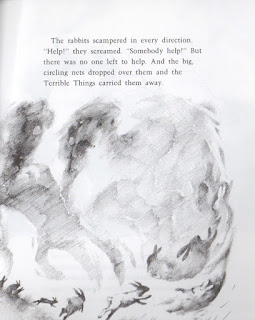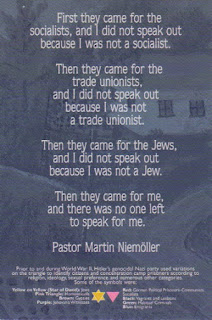Eve Bunting is a prolific and versatile writers with over 100 books to her credit. On this blog alone, I have written about two of her World War II works -
Spying on Miss Müller, a school story, and
One Candle, a Chanukah story. Among her considerable
oeuvre is a small but powerful allegory of the Holocaust and what happens when one turns a blind eye to the terrible things that are being done to others instead of standing up for what was right.
The trouble begins in a forest where everything is fine and all the animals get alone well, That is until the Terrible Things arrive, blocking out the sun and announcing that they have come for all the creatures who have feathers. Though all the feathered creatures try to fly away, the Terrible Things had brought big nets, capture them all and take them away. Seeing this, Little Rabbit doesn't understand what was wrong with having feathers, but Big Rabbit tells him not to say anything, and to mind his own business, so as not to anger the Terrible Things.
And so, it went from then on. The Terrible Things come day by day for the animals of the forest, type by type. And each time they come, the remaining animals look the other way and ignor the cries of the captured creatures. Pretty soon, the only animals left are the rabbits. But one day, the Terrible Things come for them, too...
Introducing the Holocaust to younger readers is never an easy task. On the one hand, you don't want to scare them so much they can't get beyond their own fear. On the other hand, as the Holocaust slips further and further into history, it may be difficult for kids to fully realize the importance of the lessons of tolerance we should have hopefully learned from it. The indirect way Bunting presents both of these concerns in
Terrible Things makes it a good book for readers to learn about the Holocaust and for helping kids to understand the consequences of behavior like that of the Rabbits, and for encouraging them to be brave enough to stand up for wrongs.
Bunting words are chilling and are expertly illustrated in the haunting pencil drawing by Stephen Gammell, which add so much to the ominous feeling in this story. He is spot on in the way he has captured the fear of the animals as the Terrible Things come for them, but in the sense of isolation each animal type feels as they try to flee:
 |
| "But there was no one left to help" |
Years ago, I bought a postcard at the Holocaust Museum in Washington, DC and have kept it all these years to remind me of the very thing that Even Bunting is writing about in
Terrible Things. Most people will probably recognize the words, since it is a well know quote, but I though I would include it anyway:
Unlike Pastor Niemöller's quote, I should say that
Terrible Things does end on a more hopeful note. Though it is basically a picture book,
Terrible Things can easily be used for elementary, middle school and even high school students. And there are any number of excellent lesson plans available for this book that has so much to offer in terms of teaching kids about courage, tolerance, diversity as well as the Holocaust. One example of an excellent lesson plan for older students can be found at the
Mandel Project.
This book is recommended for readers age 6+
This book was bought for my personal library
Say hi to Inez Haynes Gillmore. I know some of you are familiar with her, but I suspect most of you are not. She could easily be your new favorite author. She’s pretty good. But mostly what she is is versatile.
I read a book of hers the other day called Gertrude Haviland’s Divorce. It made me re-examine three of Gillmore’s other books, just because it seemed so unlikely that they all could have come from the same person. So, there’s Gertrude Haviland, a divorce novel — and please don’t try to tell me that’s not a genre, because I won’t listen — and then there’s an adorable children’s book, a fluffy romance/adventure/ghost story/paean to old furniture, and a disturbing, bloody, and terrifyingly upbeat allegorical feminist fantasy. All of them are, in their separate ways, perfect.
We’ll start with Maida’s Little Shop. It’s the most innocuous. There were fifteen Maida books, two of which are in the public domain, but although the series ran until the 1950s, it was obviously never intended to be a series at all — there wasn’t so much as a sequel for eleven years. I’ve only read Maida’s Little Shop and Maida’s Little House, but that’s enough to be glad there was a sequel, and to take the rest of the books on faith, because they’re lovely. Maida is the daughter of the kind of fictional millionaire of whom, despite the fact that he’s clearly a great guy, everyone is terrified. She’s also a bit of an invalid, only capable of walking because of a recent operation by one of those specialists who are always curing crippled fictional characters. All she needs to complete her recovery is to take a real interest in something, so when she expresses a desire to run a store, her father buys it for her. I might have liked to hear a bit more about the actual running of the shop — logistics, and the kind of financial detail you only get from Horatio Alger, and things like that — but the friendships she forms with the children in her new neighborhood are completely satisfactory. Based on Maida’s Little House, I expect the rest of the series revolves around Maida and her friends being happy and industrious in a variety of settings while her father spends vast amounts of money on them. And what more could you want?
Then there’s Angel Island. I don’t know how it was received when it was first serialized in The American Magazine, but right now it’s probably the most famous thing she wrote, because of all the feminism. I kind of wish it was even more feminist, though. Or maybe a bit less pessimistic about human nature. This is the story of five young men who are shipwrecked with a lot of dead bodies and even more supplies. After they’ve been hanging around on their new island home for a while, they discover that they’re sharing it with some winged women — conveniently, five of them. In spite of the language barrier, they begin to pair off, “Peachy” showing off for Ralph, “Chiquita” hanging out with Frank as he writes, etc. And then Ralph is like, “So, obviously the next step is to capture them and force them to marry us.” The other men are initially horrified by this, but eventually they all come round to the same point of view, at which point they trap the women in a cabin the’ve built and cut off their wings. That was a but of a surprise for me. There’s all this talk about capturing the women, and then once they’ve done it Gillmore is like, “and then they pulled out their freshly sharpened shears.”
Then the men proceed to “tame” the women. Which, you know, if it’s going
This has to be my most unproductive 'What I did last month' post of the year. Boo me!
Okay, let the shame begin.
1. I wrote three flash length stories.
Strange Tooth - written for and sent to Flash Fiction Online, because they pay a ridiculous amount of money for flash fiction.
Rosalind Red Stands in the Snow - sent to Allegory. I know what I wanted to achieve, but I am not certain I pulled it off.
Leviathan's Moving Theatre - another try at Cinema Spec before it closes. The story I had on hold was rejected on Black Friday.
2. One measly short story.
The Hollow Framework of the Cotton Man - not telling you where I sent that one, but somebody knows (I think).
3. Started the second draft and finally came up with a title for my MG novel: Strange Bones - currently 4740 words in.
4. Not certain this one counts. Signed up for NaNoWriMo (thanks to the guys at Graveside Tales), and within 24 hours had formulated an idea and a bunch of titles. Very excited. Very, very excited. Now I just need 50,000 words worth of plot.
Have a spook-filled, idea busting, October.





Wonderful post Alex. I'm not big on allegory for adults, to me it seems to be hiding the hard truths but for kids I think it's a wonderful idea since it hides what really human beings are capable of doing to one another.
http://www.ManOfLaBook.com
That's what I thought. The Holocaust is a hard subject to teach kids, but this is about intolerance, and I think kids can understand that, especially once they get into school.
I have read many books by this author- but don't recall hearing of this one. I do a historical fiction unit with my 5th grade students at the end of the year and many of them have no idea about what has happened in history. This sounds like a book I must read so that I can share it with my students as part of my study. I also love the quote you included. So true!